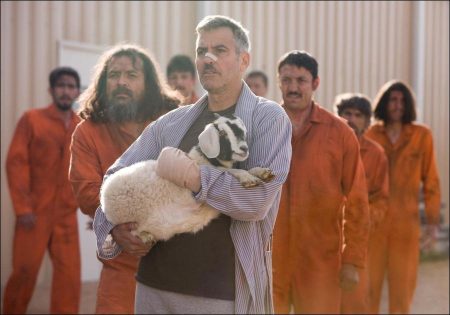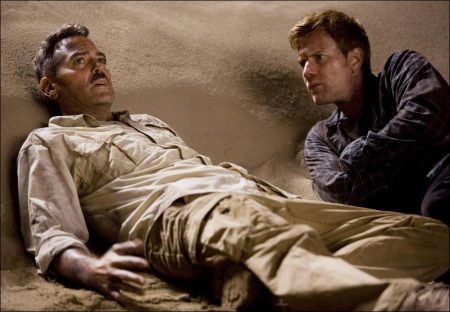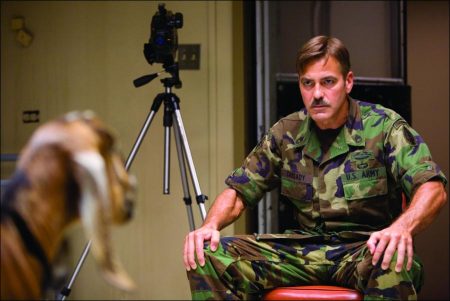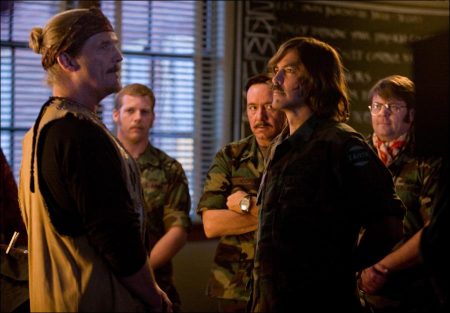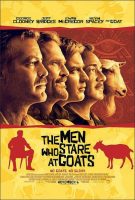Taglines: No goats. No glory.
The Men Who Stare at Goats. Reporter Bob Wilton (Ewan McGregor) is in search of his next big story when he encounters Lyn Cassady (Academy Award winner George Clooney), a shadowy figure who claims to be part of an experimental U.S. military unit. According to Cassady, the New Earth Army is changing the way wars are fought. A legion of “Warrior Monks” with unparalleled psychic powers can read the enemy’s thoughts, pass through solid walls, and even kill a goat simply by staring at it. Now, the program’s founder, Bill Django (Oscar nominee Jeff Bridges), has gone missing and Cassady’s mission is to find him.
Intrigued by his new acquaintance’s far-fetched stories, Bob impulsively decides to tag along. When the pair tracks Django to a clandestine training camp run by renegade psychic Larry Hooper (two-time Oscar winner Kevin Spacey), the reporter is trapped in the middle of a grudge match between the forces of Django’s New Earth Army and Hooper’s personal militia of super soldiers. In order to survive this wild adventure, Bob will have to outwit an enemy he never thought possible.
“The Men Who Stare at Goats” was inspired by Jon Ronson’s non-fiction bestseller of the same name, an eye-opening and often hilarious exploration of the government’s attempts to harness paranormal abilities to combat its enemies.
The film, based on true events described in Jon Ronson’s 2004 book of the same title, “The Men Who Stare at Goats,” involves a down-on-his-luck reporter (McGregor) who gets more than he bargains for when he meets a special forces agent (George Clooney) who reveals the existence of a secret, psychic military unit whose goal is to use paranormal powers to end war as we know it.
In this quirky dark comedy inspired by a real life story you will hardly believe is actually true, astonishing revelations about a top-secret wing of the U.S. military come to light when a reporter encounters an enigmatic Special Forces operator on a mind-boggling mission.
Reporter Bob Wilton (Ewan McGregor) is in search of his next big story when he encounters Lyn Cassady (Academy Award winner George Clooney), a shadowy figure who claims to be part of an experimental U.S. military unit. According to Cassady, the New Earth Army is changing the way wars are fought. A legion of “Warrior Monks” with unparalleled psychic powers can read the enemy’s thoughts, pass through solid walls, and even kill a goat simply by staring at it. Now, the program’s founder, Bill Django (Oscar nominee Jeff Bridges), has gone missing and Cassady’s mission is to find him.
Intrigued by his new acquaintance’s far-fetched stories, Bob impulsively decides to tag along. When the pair tracks Django to a clandestine training camp run by renegade psychic Larry Hooper (two-time Oscar winner Kevin Spacey), the reporter is trapped in the middle of a grudge match between the forces of Django’s New Earth Army and Hooper’s personal militia of super soldiers. In order to survive this wild adventure, Bob will have to outwit an enemy he never thought possible.
Stranger Than Fiction
Some stories seem destined to be made into movies-like this one: an army of New Age warriors is bankrolled by the U.S. government to develop methods of combat using only their minds. Amazingly, this story is true. In his extensively researched bestselling book The Men Who Stare at Goats, journalist Jon Ronson uncovers the history of the First Earth Battalion, and in the process sets the stage for an astonishing and hilarious cinematic look at a virtually unknown chapter of American military history.
When producer Paul Lister received the first two chapters of the book from Ronson’s literary agent, he found the title irresistible. “It’s such a great title,” says Lister. “It made me pick up the book right away and say, `What is this?’ And it’s the central idea in the movie.
“The chapters were very funny,” he adds. “I couldn’t wait to get the rest of the book. It was full of strange, true stories that had resonance. That was the draw for me-I thought, `Hang on a minute. How can something so funny and strange be real?’”
The book contained enough offbeat revelations for two movies, but it didn’t conform to a traditional three-act narrative. Screenwriter Peter Straughan was brought in to further develop the story into a script. “As much as I loved the book, it didn’t really present as a movie,” says Lister. “Peter came in with the vision we needed to transform it. He moved away from pure fact into a fictionalized series of events and characters inspired by the book.
“Peter delivered an unbelievably strong first draft,” the producer continues. “It was smart and funny and fresh. There’s just nothing else out there like it.”
The screenplay attracted the attention of Grant Heslov and George Clooney, partners in the production company Smoke House. Heslov, producer of films including Good Night and Good Luck (for which he also garnered an Academy Award nomination) and Leatherheads, was planning his feature film directing debut when the script came his way.
“I fell in love with it,” he says. “I read a lot of screenplays and this one made me laugh out loud from beginning to end. Jon Ronson captured this world in a very real way and Peter adapted as only a really great writer could. When I gave it to George to read, he said, `You know what? Let’s do it.’”
Clooney brought more than his cachet as an actor to the project. “George is a fantastic actor and perfect for the role of Lyn Cassady,” says Lister. “But he isn’t just a movie star. He and Grant know how to make a movie. They can put all the elements together.
“The slightly subversive nature of the material is perfect for them,” adds the producer. “It’s got a political edge. It’s got humor. The point-of-view really gelled with the way they see the world. It was great to have them as the motors that drove this forward.”
Straughan’s screenplay added another, more emotional layer to The Men Who Stare at Goats. “On the surface, it is the story of a group of men in the military who study psychic warfare,” Heslov notes. “But it’s also a road picture about two guys who are both lost in their lives and who forge a real relationship.”
In the film, the fictionalized First Earth Battalion is called the New Earth Army. “We also refer to as it `Project Jedi’ in the film,” says Heslov. “They actually called themselves Jedi Warriors. It was all about freeing your mind and coming up with new nondestructive methods of warfare.”
Lister finds the idea of a group of forward-thinking military men who come together to embrace the spirit of the New Age inspiring. “They wanted to find new ways of fighting wars without harming anybody,” says the producer. “In our story, this fantastic, idealistic, new way of fighting wars gets corrupted, which is also what happened in the real world.”
Jim Dever, a retired sergeant major in the Marine Corps with 25 years of service and the film’s military consultant, was shocked to discover the story was based in reality. “When I got the script, I said, “Is this for real? Did this happen in the Army?” So I did research. It was all there.”
Jon Ronson was inspired to write The Men Who Stare at Goats after hearing an unlikely and fascinating story about a low-profile U.S. Army effort to harness extra sensory perception and telepathy for the purposes of warfare. Jim Channon, a former lieutenant colonel with the Army, told Ronson he was one of the founders of the First Earth Battalion, and had written the field manual for the group after years of research into philosophy, martial arts, psychic arts, healing, psychology and a range of extrasensory experiences. “They were a group of military men, some highly placed, who desperately wanted to learn paranormal abilities,” says Ronson. “They really did try to walk through walls and become invisible. They practiced greeting the enemy with `sparkly eyes,’ and eventually, at Fort Bragg, when the ideas turned darker, they tried to kill goats just by staring at them.”
Channon became interested in alternative warfare after his service in the Vietnam War. He began to investigate a wide array of New Age techniques, including Reichian rebirthing, primal arm wrestling and naked hot tub encounter sessions in order to revolutionize the military. A 125-page mixture of drawing, graphs, and essays detailing a complete overhaul of the traditional army, the manual draws on sources as diverse as Buckminster Fuller, Leonardo Da Vinci and Buddha. It covers topics from visualization techniques and total fitness to the slightly more esoteric “Ethical Combat” and “Earth Prayers.”
“Jim spent years studying with different gurus and New Age movements,” says Heslov.” “When he came back, he wrote a manifesto, so to speak. It outlines a way to fight wars in a peaceful manner. It gets pretty detailed, from the way to deal with the enemy to certain battle tactics.”
Channon convinced his superior officers to allow him to take charge of a battalion of soldiers trained in psychological and paranormal warfare techniques, including remote viewing-an out-of-body experience that enables the subject to see events taking place thousands of miles away-and invisibility.
According to Jon Ronson’s meticulously researched book, Major General Albert Stubblebine III was among the first to envision an army of the future that would use advanced sensory techniques to resolve international conflicts. General Stubblebine, a West Point graduate and the commanding general of the United States Army Intelligence and Security Command (INSCOM) from 1981 until his retirement in 1984, passionately believed that every human being alive was capable of performing supernatural miracles.
The general was intrigued by Jim Channon’s vision of ending conventional warfare with a battalion of “warrior monks” who could see into the future, read minds, become invisible and teleport. He threw the full weight of his influence behind the idea of a New Age army in a series of under-the-radar projects at Fort Meade. He also devoted considerable time to harnessing his own psychic powers, hoping to perfect the art of phasing-which includes the ability to walk through walls.
“The first scene in the book is Major General Stubblebine getting up from behind his desk in Arlington, Virginia,” says Ronson. “He announces he’s going into the next office, breaks into a jog, and then bumps his nose hard on his office wall.”
Soon after becoming head of INSCOM, Stubblebine instituted a program called the High Performance Task Force. The Task Force utilized New Age techniques including neurolinguistic programming and brain synchronization, and sent some of its officers to the Monroe Institute, dedicated to the study of human consciousness.
According to Ronson, the program started very simply. “First the CIA, and then the Department of Defense, got a bunch of soldiers, stuck them in a secret room and told them to be psychic.”
“They experimented with things that sound absurd, like `race-specific stink-bombs’ and subliminal sounds and `attack bees’,” he continues. “The first leader of the remote viewing unit-a CIA man called Sidney Gottlieb-also ran a very dark endeavor called MK-Ultra. They would secretly spike the drinks of unsuspecting military people with LSD.”
“They explored all kinds of philosophies and devices to fight non-lethal wars,” says Lister. “They investigated things like `The Predator,’ a little plastic blob that looks like a children’s toy but is actually very dangerous.” The official files on the First Earth Battalion remain sealed and the Army says their psi-ops programs were long ago disbanded. But veterans of the program continue to wield influence in and out of the military, including Jim Channon, who is now known as “a global elder” and “the world’s first corporate shaman”; John Alexander, a leading expert on non-lethal weapons; Joseph McMoneagle, one of the original recruits who psychically identified a previously unknown Soviet submarine; Ingo Swann, originator of the term “remote viewing” and developer of the first training protocols; Lyn Buchanan and Mel Riley, who currently offer psi-ops services through a private company in Washington, D.C., and Ed Dames, sometimes called “the real Obi Wan Kenobi,” a renowned remote viewing expert and trainer.
The filmmakers spoke with Channon as they prepared for the film. “Jim is really a smart, free-thinking individual,” says Lister. “He’s a fantastic guy and a huge supporter of the movie. Even though we’ve fictionalized his endeavors, I think he hopes that people will see the movie, have fun, and then make the connection back to the First Earth Battalion.”
Heslov and Clooney pride themselves on running an easygoing set, and by all accounts, the light-hearted tone of the film continued even when the cameras stopped rolling. “We try to do it the same way we run our business,” says Heslov. “We try and have fun. Making movies can be tense. It’s all-consuming. You only have so much time, you only have so much money, so we really try to make it a pleasurable experience.” “Grant did a splendid job,” says Jeff Bridges, one of the film’s stars. “He created a wonderful atmosphere that was relaxed and focused. He was always open to ideas from the actors, and was very inclusive that way. He came very prepared. I think audiences are in for a wonderful surprise. There’s no way really to describe it. The tone of the movie is funny, scary, serious, endearing. It’s the full gamut of emotions.”
“It is very, very funny and clever and-most of all-it has a big heart,” says Ronson. “Everyone is fantastic in it. Some of the book’s darkness is in there too, but just the right amount. I’m very proud.”
Recruiting the New Earth Army
In addition to crafting an irresistible narrative, screenwriter Peter Straughan created a number of plum roles that attracted some of Hollywood’s top acting talent. “We’re so lucky to have this great cast that George and Grant brought together,” says Paul Lister.
Clooney’s well-known sense of humor set the tone for the production, both on and off-camera. He plays Lyn Cassady, a conscript to the New Earth Army. “George is a really funny guy,” says Heslov. “He knocks it out of the park in this role. On top of that, he also brings a real grounded gravitas, and a salt-of-the-earth quality to the character.”
Lyn’s mentor, Bill Django, is played by Academy Award nominee Jeff Bridges. “Django is the founder of the New Earth Army,” explains Lister. “He’s a visionary and a free thinker who has fallen on hard times. Towards the end of the movie, he has to reclaim his role as leader. Jeff brought enormous creative energy to the set. He’s full of ideas and wants to explore different ways of doing things that give the director and the editor many options.”
The character is a composite drawn from several characters in Ronson’s book, says Bridges. “I got a lot of inspiration and a lot of valuable information from Jim Channon, who is a pioneer in this field,” he says. “And I used my memories of John Lilly. He’s the guy who invented the isolation tank. He also worked on interspecies communication with dolphins. He was a big inspiration for me.”
The Men Who Stare at Goats appealed to Bridges as the kind of film he would like to see himself. “I like to be surprised,” the actor says. “This certainly fits that bill. I’ve never seen anything like this movie. You don’t know what to expect next. It takes you on a wild adventure.”
The chance to work with actors he likes and admires was also a big draw for Bridges. “Kevin Spacey is a good friend of mine. It’s always great to be able to play with your buddies, and he’s wonderful in the part.” Spacey plays Larry Hooper, a renegade Jedi. “In every organization, there’s a character that could spoil the fun for everyone else,” notes Lister. “That’s Kevin’s role in this movie, and he does it with a twinkle in his eye.”
Hooper is the kind of character Spacey excels at portraying, says Heslov. “He gets under the skin of this guy-and he’s also incredibly funny. Hooper embodies the exact opposite of the spirit that all these guys should have and there’s a competition between his character and George’s character, Cassady. At least, he’s in competition with Cassady, although Cassady isn’t really in competition with anybody.”
The film marks the first time Bridges and Ewan McGregor have worked together, and the actors developed a strong bond during their scenes together. “Ewan’s role is the thread that runs through the whole movie,” says Bridges. “We have some dance scenes and crazy, crazy stuff we do together.”
McGregor was eager to work with Bridges as well as Clooney. “There’s a list of actors that I’d like to work with, and both of them were on there,” he says. “I did work with George on an episode of `ER’ years ago and I’ve always wanted to work with him again.
“Then when I heard that Jeff was involved, I was beside myself,” he continues. “Jeff’s incredibly meticulous and well-prepared, and then you really get to play with him when the camera is turning. We did this amazing tai chi exercise on top of a container in the middle of the desert as the sun was setting. It’s one of those movie moments that I won’t ever forget.”
Like most people, McGregor was unaware of the existence of the First Earth Battalion before getting involved with the film. “I knew nothing about it or about Jim Channon,” he says. “Making my character a journalist is a very clever way of presenting the information. I’m asking all the questions and soaking it all in, just like the audience.”
Hurricans, Blizzards and Fainting Goats
The Men Who Stare at Goats takes its characters from small town Michigan to the Iraqi desert, with several stops along the way. “This is a little film with big ideas and big locations,” says Paul Lister. “It took a lot of wrangling. This story takes place briefly in 1970s Vietnam. We’re in the 1980s. We’re in 2003. We’re in Iraq. We’re in Fort Bragg. It’s really got scope and that means there was a lot of moviemaking to be done.”
Location scout S. Todd Christensen covered over 14,000 miles finding the right locations for the film, a personal record. “There was one day of scouting that started in Albuquerque, went 80 miles to the Zia Pueblo, then to Roswell, Mescalero Flats, White Sands and Alamogordo,” Christensen remembers. “By the time we got back to Albuquerque, we had driven 700 miles in just over 16 hours. As I told Grant, it was my biggest day ever.”
Christensen found some stunning backdrops for the film in his travels. “I found a dry lake bed in Willard, New Mexico on Google Earth,” he says. “It’s this vast 10-mile dry lake bed that’s alkaline, so it’s very white and absolutely gorgeous. It’s also very desolate. No plant life; there’s very little of anything but sand, which is what they wanted.”
Shooting New Mexico for the Iraqi desert worked well visually, but the weather was not always cooperative. “It turned very cold towards the end of the shoot,” says Heslov. “In the film, it was supposed to be 100-plus degrees and it was 30. George and Ewan were in T-shirts, but sometimes you just have to shoot, so we worked around it. When it started snowing, we had to stop for a couple of hours and wait for it to melt.”
That was what McGregor refers to as “an interesting acting exercise.” “You take off all the layers and tell yourself `Okay it’s warm, it’s warm, it’s warm. Someone would have to put sweat on us, which just makes you colder, of course. It was bizarre.”
To stand in for Vietnam, the filmmakers shot in Puerto Rico during hurricane season. Jon Ronson and Peter Straughan joined the cast and crew there. “When they started filming, I thought George Clooney and Ewan McGregor must be having unimaginable fun,” says Ronson. “I wanted to be part of it. So Peter and I flew to Puerto Rico. It turned out that they weren’t having unimaginable fun. They were working very hard, for very long hours in really quite arduous circumstances.”
Substituting for Fort Bragg in North Carolina is the New Mexico Military Institute. “They hadn’t done any filming there since Dress Gray in 1986,” says Christensen “They had a lot of rules. There was one scene I call the `naked guy scene’ that they had some difficulty with so he ended up wearing a skin-colored Speedo.”
And if the filmmakers had any doubts about the authenticity of their information, it was dispelled during their time at the school. “While we were shooting there, we were approached by a representative of the college,” says Lister. He had looked at our shooting schedule and saw “Jedi Earth Prayer.” And he said, `Hang on a minute. I did that.’ He had been a part of the First Earth Battalion. This guy was there when they invited Uri Geller, the famous psychic, to demonstrate how to bend a spoon with the power of the mind!”
And then, of course, there were the goats. The filmmakers needed a herd for some of the movie’s most critical scenes. Heslov heard about a particular variety that seemed ideal. “They’re called “Fainting Goats’ for obvious reasons,” he says. “These goats pass out when they’re startled. Our cinematographer, Robert Elswit, had seen them on television and they seemed perfect. So we got some goats in and we did a test. But when we startled the goats, they didn’t faint. Nothing. They were just regular goats. I know these goats do exist, but we didn’t see them, so we had to use normal everyday goats.”
Mary Duree, the goat wrangler, says that while goats are highly intelligent, they received no special training for the film. “Goats are easy to make look like they’ve been hypnotized,” she says. “They’re very curious, so they’ll gather up together and just gaze at you. They’re comical animals in a lot of ways.”
Goats are notoriously playful and will cause a commotion when they’re bored. The solution is simple, says Duree. “Their biggest entertainment is eating. Food keeps them quiet.”
Despite some of the apprehensions the filmmakers had, the goats proved easy to work with and popular on the set. “They’re very responsive,” says the director. “George was sure the goats were going to be difficult. He talks a mean game, but once he had a baby goat in his arms, it was love at first sight.”
The time is always right for a good comedy, and according to Paul Lister, The Men Who Stare at Goats is much more than just that. “Recent foreign policy decisions have caused us as a country to ask some big questions. Finding our way out of those problems is going to take some out-of-the-box thinking, and this is a story about how to think out of the box.”
The Men Who Stare at Goats (2009)
Directed by: Grant Heslov
Starring: George Clooney, Ewan McGregor, Kevin Spacey, Jeff Bridges, Rebecca Mader, Terry Serpico, Glenn Morshower, Stephen Root, Jacob Browne, Todd Lawson LaTourrette
Screenplay by: Peter Straughan, Toby Young
Production Design by: Sharon Seymour
Cinematography by: Robert Elswit
Film Editing by: Tatiana S. Riegel
Costume Design by: Louise Frogley
Art Direction by: Peter Borck
Music by: Rolfe Kent
MPAA Rating: R for language, some drug content, brief nudity.
Distributed by: Overture Films
Release Date: November 6, 2009
Views: 88
